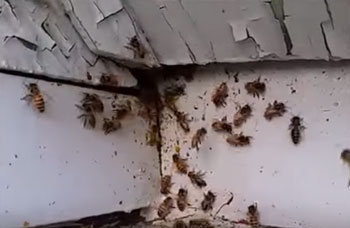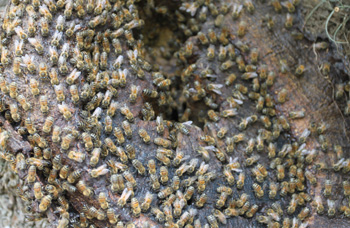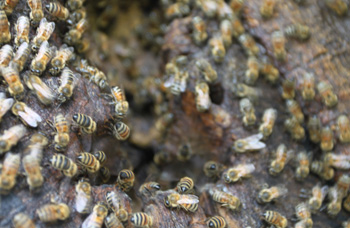Bees
Honey Bees Facts
- Typically 11 to 15mm in length.
- Can be identified by their size and black/brown and yellow coloring.
Bee Photos
-
 Honey Bees
Honey Bees -
 Honey Bees
Honey Bees - View More Photos
Honey Bees
Honey Bees get their name from breeding for honey production. They are resistant to diseases and have a non-aggressive temperament. They can typically be identified by their size and black/brown and yellow coloring. They have dense hairs on the pronotum and thinner hairs on the abdomen.
What Are Honey Bees?
Honey Bees are a social insect and populate in colonies. These colonies have a three-tier caste system which consists of: the queen bee that is responsible for producing eggs; male drones that mate with the queen; and female worker bees that don’t reproduce. Their wax hives are perennial and can harbor up to 80,000 bees simultaneously. They stay most active in summer months; during winter, bees gather within the hive and self-regulate the internal temperature to keep warm. Honey Bees are greatly depended upon in agriculture for pollination and they account for 80% of all insect pollination.
Honey Bee Infestation
In recent years, Honey Bee populations have suffered greatly. Research points to environmental factors such as pathogens, pesticides, and immune system damage as some of the key causes of this. Honey Bees are considered mostly beneficial due to their pollination of agriculture and production of honey, pollen, beeswax, and royal jelly. Although they can sting, they are typically non-aggressive and most Honey Bee stings occur due to provocation or by accident.
How to Get Rid of Honey Bees
While it’s essential people remain conscious of the decline of Honey Bees, if they become a threat to a person’s home structure, homeowners should remedy the issue. First, the homeowner should determine the location and severity of the infestation. If the swarm is dense or the hive is in a difficult place, it’s best for the homeowner to contact a professional.
If the hive is only a couple of days old, then the colony likely has not had enough time to build a strong comb structure. The homeowner can then inject a bee control pesticide into the infestation area. Once the pesticide is applied, it affects all of the honey within the hive as well. When the hive is older than a couple of days, a “naturalization” process can be used. This process involves the complete removal of all bees, hive, and honey that may be part of the infestation. This removal is essential in preventing mold development or future pests which may be attracted to the sweetness of the honey. After removing the entire infestation, a wash down with soapy water will clean the area.
Honey Bee Stings & Treatment
Generally, Honey Bee stings do not pose a health concern unless the individual stung is allergic or sensitive. If the stung person is allergic, immediately go to the hospital or use an epinephrine shot, if available. Worker bees have a barbed stinger with an attached poison sac that is left in the skin once stung. Remove the stinger and poison sac promptly after being stung by scraping with tweezers or fingernails.


